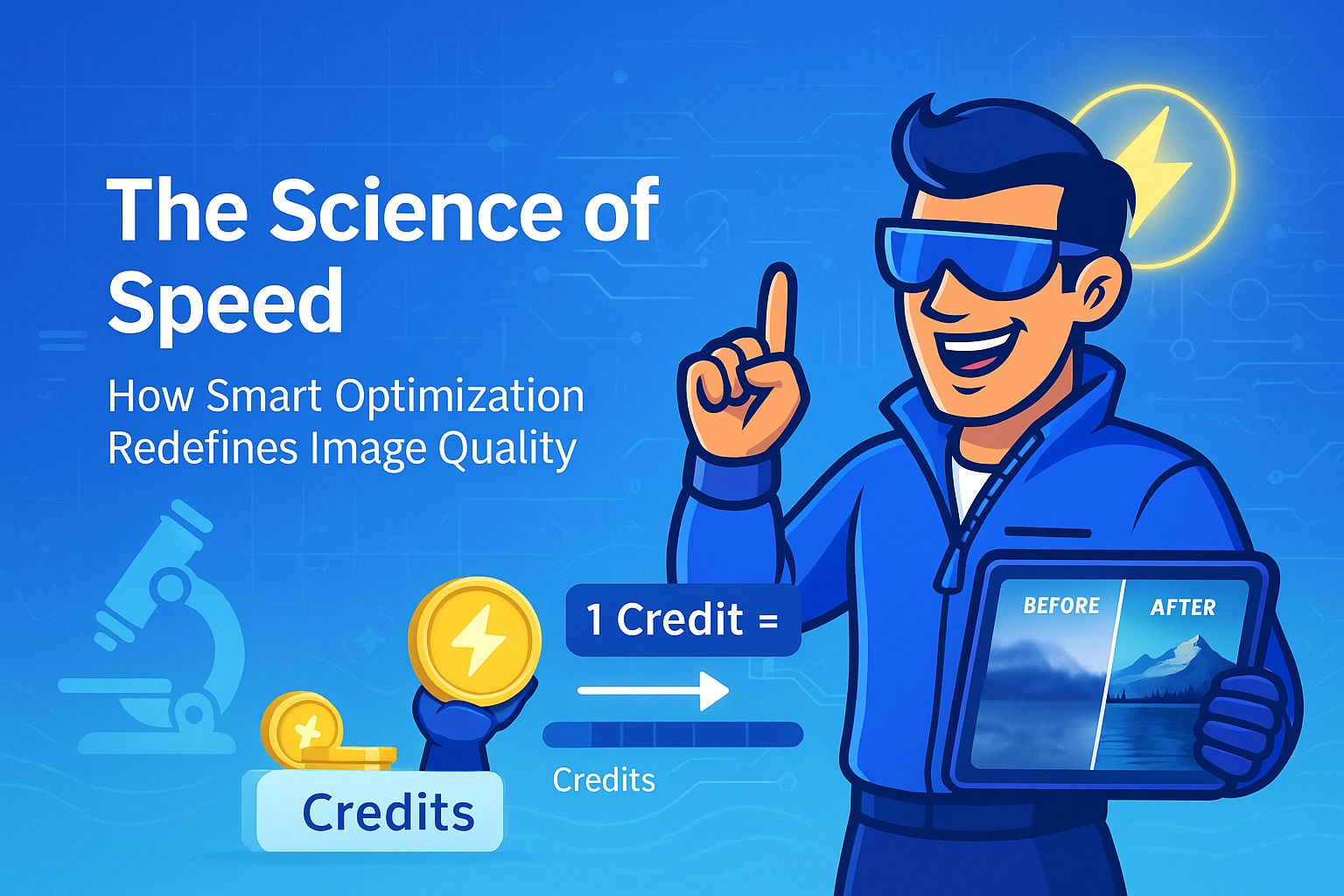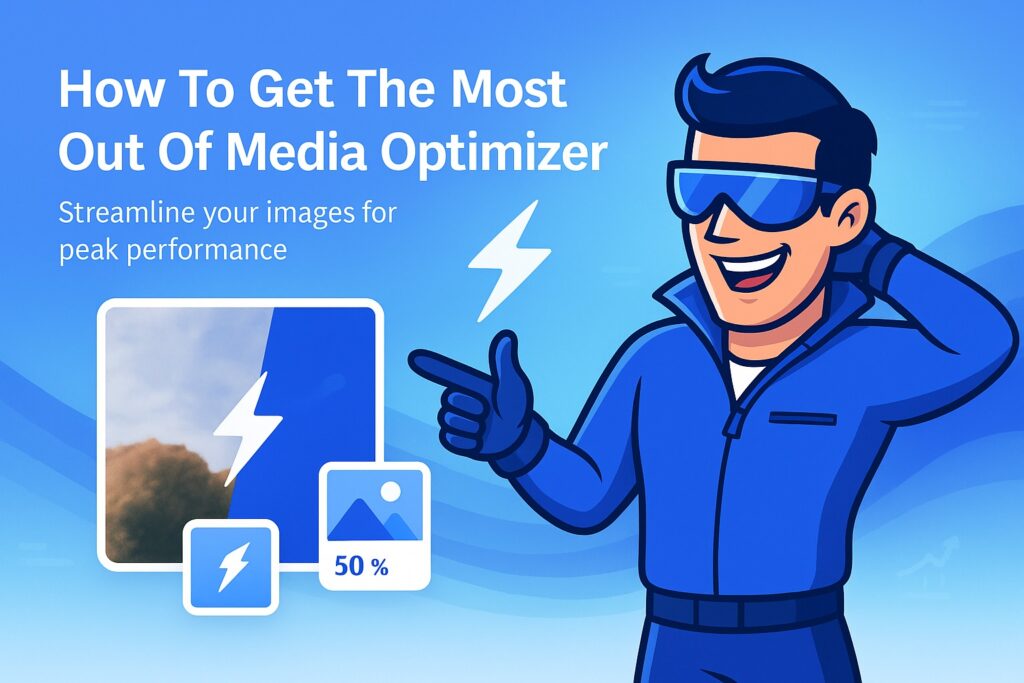The Science of Speed: How Media Optimizer’s “Smart Optimization” Redefines Image Quality

Go beyond simple compression. Discover the advanced perceptual algorithms, psycho-visual tuning, and intelligent analysis that power our “Smart Optimization” engine. Learn how we deliver images that are both drastically smaller and visually superior, and why it’s the key to unlocking peak web performance.
Table of Contents
In the world of web performance, every kilobyte counts. For years, the goal of image optimization has been a simple trade-off: sacrifice a little bit of quality to gain a lot of speed. Standard compression tools, even modern ones, operate on this basic principle. They apply a uniform set of mathematical rules across an entire image, hoping the resulting quality loss is “good enough” for the web.
But what if “good enough” isn’t good enough?
What if you could achieve drastically smaller file sizes while also preserving the critical details, textures, and vibrant colors that make your images compelling? What if an algorithm could understand an image the way a professional photographer does, protecting what’s important and compressing what isn’t?
This is the philosophy behind Media Optimizer’s Smart Optimization. It’s not just another quality slider; it’s a fundamentally different approach to image compression. It’s a suite of advanced, perceptual algorithms designed to optimize images for the most sophisticated engine of all: the human eye.
This deep dive will pull back the curtain and show you exactly what happens when you enable this powerful PRO feature.
Beyond Mathematics: The Problem with Standard Compression
To understand why Smart Optimization is a game-changer, we first need to understand the limitations of standard compression.
When you save a JPEG at “85% quality,” the algorithm doesn’t truly understand your image. It simply applies a mathematical formula called a Discrete Cosine Transform (DCT) to blocks of pixels, discarding data it deems less important to reduce file size. This process is uniform and “dumb.” It treats a smooth blue sky with the same importance as the intricate details of a person’s face or the sharp edges of text on a product.
This leads to common compression artifacts that degrade the user experience:
- Blocking: Visible squares or blocks, especially in smooth gradients.
- Blurring: Loss of fine textures and sharp edges.
- Banding: Unnatural, step-like transitions in colors.
- Color Bleeding: Colors losing their sharpness and bleeding into adjacent areas.
Smart Optimization was engineered to solve these problems by shifting the goal from mathematical similarity to perceptual similarity.
The Pillars of Smart Optimization: A Deep Dive
When you send an image to our Smart Optimization engine, it undergoes a multi-stage analysis and encoding process. Here are the key technologies at work, explained in plain English.
1. Perceptual Tuning with SSIM
This is the cornerstone of our smart engine. Instead of just measuring the mathematical difference between the original and compressed image (a metric known as PSNR), we use a more advanced model called the Structural Similarity Index (SSIM).
SSIM is a psycho-visual model that evaluates the quality of an image based on how a human would perceive it. It focuses on three key factors:
- Luminance (Brightness): Are the light and dark areas consistent?
- Contrast: Are the differences between light and dark areas preserved?
- Structure: Are textures, edges, and patterns intact?
By telling our AVIF encoder to “tune for SSIM,” we are instructing it to prioritize these structural elements above all else. It may slightly alter pixel-perfect color values in a way that a computer would notice but a human would not, in order to preserve the critical texture of a fabric or the sharpness of an eye.
The result: An image that feels sharper, clearer, and more detailed, even at a file size that would cause a standard compressor to produce a blurry mess.
2. Intelligent Bit Allocation with Adaptive Quantization
This is where the true “intelligence” comes into play. Imagine you have a limited budget of “data bits” to spend on an image. A standard compressor spends them evenly everywhere. Adaptive Quantization (AQ) acts like a savvy investor.
It first analyzes the entire image to identify areas of varying complexity:
- High Complexity: Areas with a lot of detail, sharp edges, and textures (e.g., hair, text, foliage).
- Low Complexity: Smooth, uniform areas (e.g., a clear sky, a painted wall).
The AQ algorithm then dynamically allocates the data budget. It “spends” more bits on the high-complexity areas to preserve every detail with pristine clarity. Simultaneously, it “saves” bits by applying stronger, invisible compression to the simple, low-complexity areas.
This prevents the most common compression problem: blurry text or fuzzy faces. AQ ensures that the parts of the image your visitors actually focus on are given the VIP treatment.
3. Uncompromising Color Fidelity (Chroma DeltaQ and -sharp_yuv)
One of the biggest challenges in aggressive compression is preserving vibrant, accurate colors. This is especially true for the color red, which is notoriously difficult to compress. Our Smart Optimization engine uses two key techniques to ensure your brand colors and photos look perfect.
- For AVIF (enable_chroma_deltaq): This advanced feature allows the encoder to use a separate, more gentle quality setting for color information (chrominance) compared to brightness information (luminance). Since the human eye is more sensitive to shifts in brightness than in color, this technique allows us to aggressively compress the brightness data while delicately preserving the color data. It’s the secret to avoiding that “washed-out” or faded look and keeping your reds looking like reds.
- For WebP (-sharp_yuv): This is a sophisticated and computationally intensive process that ensures color values are not “smeared” or “bled” during compression. It performs more accurate conversions between RGB (your monitor) and YUV (the color space used for compression), resulting in sharper color transitions and preventing color bleeding around high-contrast edges.
4. Maximum Effort Encoding
Finally, Smart Optimization tells our encoders to take their time.
- For WebP The encoder will analyze the image much more deeply, trying out thousands of different prediction methods to find the most efficient way to store the data. We also enable multi-pass encoding (-pass 10), where the encoder analyzes the image up to 10 times to create a perfect “map” of its complexity before committing to the final compression.
- For AVIF: This forces the AV1 encoder to use its most advanced and complex algorithms. It takes longer, but the resulting file size savings are significantly greater than at faster speeds.
The “Quality vs. Size” Trade-off: A New Paradigm
In our Smart Optimization mode, we occasionally make a deliberate choice: we prioritize ultimate visual quality over squeezing out the last possible byte.
In rare cases—typically with extremely high-quality, professional photographs that are already very well compressed—our perceptual algorithms may determine that applying further standard compression would introduce a noticeable, negative artifact. To avoid this, the engine might produce a file that is a few percent larger than a “dumb” compressor would.
However, in return for those few extra kilobytes, you get a guarantee of pristine, visually lossless quality. The image will be free of blurring, banding, or color shifts. We believe this is the right compromise for any professional website where visual quality is paramount.
Conclusion: It’s Not Just Smaller, It’s Smarter
Enabling “Smart Optimization” is about more than just settings; it’s about upgrading your entire approach to web images. You’re telling our platform to treat your images with the care of a digital artist, not a blunt mathematical instrument.
You’re leveraging a cloud-based supercomputer to perform complex, psycho-visual analysis that would be impossible to run on a typical web server. The result is a faster, more beautiful website that delights your visitors and satisfies Google’s demand for speed, all with the simple flip of a switch.

